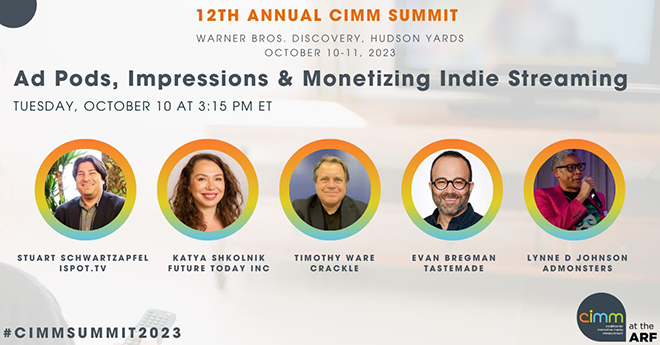
The Independent Streaming Alliance (ISA) reported that independent streaming providers generate over half a billion hours of watch time monthly. Does that mean the industry is all success and no foul? Not quite.
Due to its infancy, streamers need help to quantify these diverse audiences’ value and integrate them into the broader media ecosystem. The current state of measurement struggles to fully capture the significance of independent streamers, creating a need to establish common standards to support the “indie” ad marketplace.
At the CIMM Summit, industry experts Stuart Schwartzapfel, EVP, Media Partnerships at iSpot.TV; Katya Shkolnik, Head of Partnerships at Future Today; Timothy Ware, Senior Vice President, Programmatic Sales and Partnerships, at Crackle; and Evan Bregman, General Manager, Streaming at Tastemade, discussed the need to address these challenges and the uphill battle publishers will face addressing consumer targeting in the independent streaming wars.
Will organizations like the IAB, the government, or entities like The Trade Desk establish industry standards to help mitigate the complexities? Whatever the solution, independent streamers need help connecting with their hyper-engaged audiences.
Essence of Hyper-Engaged Audiences
In this age, viewers demand top-quality content that keeps them engaged, entertained, and glued to their screens. Various streaming platforms like YouTube have succeeded at this, providing better content that captures their audience’s attention. Advertisers can leverage such platforms to reach contextually relevant audiences. However, the downside is that the ecosystem needs more infrastructure to connect advertisers with these hyper-engaged audiences, and building this infrastructure will take time.
“…But right now, the ecosystem is not necessarily set up in such a way that you could find them,” said one of the Summit panelists.
The good news is that the potential for success is vast since advertisers are increasingly encouraged to invest in streaming alongside traditional linear TV.
On the Birth of the Independent Streaming Alliance
At the heart of the streaming revolution is the Independent Streaming Alliance, a collective of independent streamers determined to challenge the dominance of prominent players. The ISA’s genesis was rooted in shared concerns, fueling a collaborative effort to amplify the impact of independent streamers. Through strategic partnerships and joint initiatives, the ISA represents the collective strength of independent streaming platforms.
Bregman said that independent streamers are actively forging partnerships to bolster their presence in the market. Collaborations between various platforms, data providers, and advertisers are pivotal in building an efficient ecosystem. These partnerships enhance content offerings and facilitate knowledge exchange, helping participants stay ahead of industry trends and challenges.
Collaborations with measurement companies like ISPOT.TV enabled these streamers to gather invaluable data, including reach, impressions, and frequency. Their collaborative endeavors yielded a profound insight: independent streamers collectively reach approximately 15% of US TV households, indicating a substantial and engaged audience base.
Challenges in Measurement and Standardization
Despite their impressive reach, independent streamers encounter challenges in measurement and standardization. The absence of common standards hampers their seamless integration. Addressing issues related to ad pods, impressions, and metrics necessitates concerted efforts to establish foundational standards for measurement.
“So if we kind of put on the buyer hat, it’s vital to note that diversifying offerings of different publishers and supply are important to the brand,” said one of the panelists.
They pointed out the dominance of a handful of agencies, with a staggering 80 to 90% of revenue allocated among them. However, their anticipation rested on the paradigm shift expected among smaller, local brands.
Independent streamers are pioneering innovative approaches, such as contextual relevance, to enhance the value proposition for advertisers. By offering transparent and detailed insights into their content metadata, these streamers provide advertisers with a clearer understanding of their offerings. Transparency ensures advertisers can make well-informed decisions when investing in independent streaming platforms.
Schwartzapfel asserts that achieving measurement standardization involves standardizing big data and set-top box data. Standardization ensures accurate targeting and personalization of ads and enhances ad effectiveness and monetization potential.
Ad Pods, Impressions, and the Future of Indie Streaming
While ad pods and impressions remain integral components of the discussion, the broader focus lies in unlocking the potential of independent streaming. Independent streamers can redefine the streaming landscape by emphasizing the value of partnerships, contextual relevance, and transparent measurement practices, paving the way for a diverse and thriving ecosystem.
“We’ve got advertisers who traditionally buy in linear. They’re being told by the likes of Paramount and others who have spoken today very eloquently, hey, you can buy streaming as well,” added one of the panelists.
Traditional linear TV buyers are adapting to purchasing streaming inventory, and digital buyers are venturing into the CTV space. However, challenges persist in the measurement and buying process, including inconsistent measurement metrics, attribution difficulties, and the need for inventory transparency. These challenges hinder effective decision-making and necessitate collaborative solutions.
Importance of Diversification in Offerings and Looking Ahead
Diversifying offerings is instrumental in expanding reach and engaging new audiences, strengthening the position of independent streamers in the industry. Diversification increases reach, captures niche markets, enhances revenue streams through various content formats like podcasts and on-demand videos, boosts user engagement, and ensures a competitive edge. Diversification is vital; different publishers and supply options are essential for brand success.
Independent streaming must rely on collaboration, innovation, and a collective commitment to overcoming challenges. As they continue to forge ahead, their collaborative initiatives and strategic partnerships drive the indie streaming industry toward a vibrant and prosperous future.
YouTube channels present an opportunity for advertisers to reach contextually relevant audiences. However, the lack of infrastructure to find these audiences and the absence of standardization in measurement pose setbacks. Forming partnerships and alliances among independent streamers is a positive stride toward measuring audience size, diversifying offerings, and bolstering a robust indie ad marketplace.